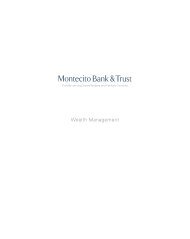Impact Magazine Issue One 2017
Create successful ePaper yourself
Turn your PDF publications into a flip-book with our unique Google optimized e-Paper software.
owner partnerships with various regional investors. Catering to<br />
the needs of college students, Orfalea sought out locations near<br />
college campuses, but the clientele soon expanded to include all<br />
manner of customers.<br />
Fueled by its open-all-hours policy, Kinko’s spread internationally,<br />
establishing over 1,200 locations with 23,000 employees in 10<br />
different countries. In 1997, Orlafea sold a stake in Kinko’s to the<br />
investment firm of Clayton, Dubilier & Rice and left the company<br />
in 2000. In 2004, Kinko’s was acquired by FedEx Corporation and<br />
became FedEx Kinko’s, later being rebranded as FedEx Office.<br />
Deckers<br />
In 1973, Doug Otto was wrapping up studies for a B.A. in Business<br />
Economics at UCSB, when he teamed up for a business venture<br />
with classmate Karl Lopker.<br />
In a footwear fashion landscape strewn with penny loafers and<br />
wingtip shoes, the pair started making sandals aimed at the local<br />
surf community, and initially sold their wares at craft fairs up<br />
and down the west coast. During a trip to Hawaii, Otto heard<br />
the locals referring to flip-flops as ‘deckas’ and, upon his return<br />
home, he christened his creations Deckers.<br />
With the burgeoning success of Deckers, the company started<br />
purchasing other casual footwear brands to add to its company.<br />
In 1982, Lopker left the company to join Santa Barbara-based QAD<br />
Inc., a software company founded by his wife, Pamela Lopker.<br />
Otto remained at the helm of Deckers Outdoor Corporation<br />
until his retirement in 2008. Now boasting brands such as UGG,<br />
Teva, Sanuk, Ahnu and Hoka <strong>One</strong> <strong>One</strong>, in 2010 Decker’s revenue<br />
surpassed the $1 billion mark.<br />
Territory Ahead<br />
Santa Barbara’s outdoor-oriented lifestyle has nurtured more<br />
than just footwear. After working for companies such as LL Bean<br />
and Espirt, in 1987 Bruce Willard made the professional move<br />
from the Bay Area to Los Angeles. Electing to base himself in<br />
Santa Barbara, Willard commuted south each day, but in 1989<br />
gave up the drive completely when he founded Territory Ahead.<br />
“I wrote the business plan for Territory Ahead on the steering<br />
wheel of my Saab, while driving back and forth to Los Angeles,”<br />
Willard told <strong>Impact</strong> <strong>Magazine</strong>. “Santa Barbara is really quite a<br />
supportive community. It’s a small but creatively vibrant place<br />
where it’s relatively easy to get to know people, so I found it a<br />
very supportive town for starting a business.”<br />
Bruce Willard, Territory Ahead Founder<br />
“I wrote the<br />
business plan for<br />
Territory Ahead<br />
on the steering<br />
wheel of my Saab,<br />
while driving back<br />
and forth to Los<br />
Angeles”<br />
In 2000, Willard stepped down as Territory Ahead’s<br />
President. The chief executive with Territory Ahead<br />
subsequently sold the company to Massachusettsbased<br />
Distinctive Apparel. Willard has gone on to be<br />
the driving force behind several other locally based<br />
clothing companies including Carbon to Cobalt,<br />
True Measure, and 32 Bar Blues.<br />
Sonos<br />
The tech industry has also tapped into Santa<br />
Barbara’s inherently creative soul. In 2002, John<br />
MacFarlane, Craig Shelburne, Tom Cullen and<br />
Trung Mai founded Santa Barbara-based Sonos,<br />
developing and manufacturing a range of highquality<br />
smart speakers. Now, with offices in 12<br />
countries, the company opened its first Sonos Store<br />
in New York City last year.<br />
Procore<br />
In 2003, Craig “Tooey” Courtemanche launched<br />
Procore, a project management software<br />
application he created in response to issues<br />
he was having with the construction of his new<br />
Santa Barbara home. Designed to support<br />
input from several sources, the software allows<br />
the management of everything from meeting<br />
minutes to drawing markups, while also providing<br />
document storage capacity for all project-related<br />
materials.<br />
Procore started in Montecito with just a handful of<br />
employees, Deckers was born from local craft fairs<br />
and Kinko’s first served the copying needs of UCSB<br />
students. If one thing can be learned about Santa<br />
Barbara’s role in fostering some of the country’s<br />
leading enterprises, it is this: the greatest driving<br />
force behind the success has been Santa Barbara’s<br />
greatest resource – its people.<br />
“There’s a highly creative and highly innovative<br />
environment here,” Garufis said. “I’m sure the<br />
weather and the location and beauty have something<br />
to do with it. Santa Barbara is a very inspirational<br />
place to live, but you’re also surrounded by people<br />
who really want to change the world.”<br />
4 / FEATURE STORY




